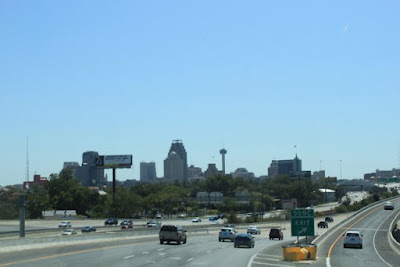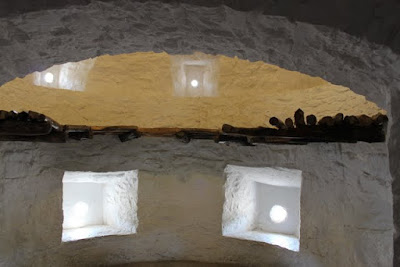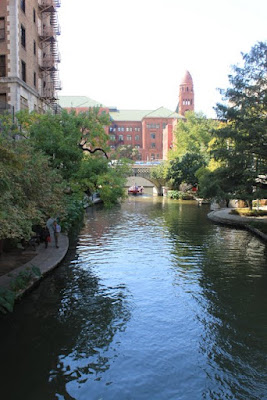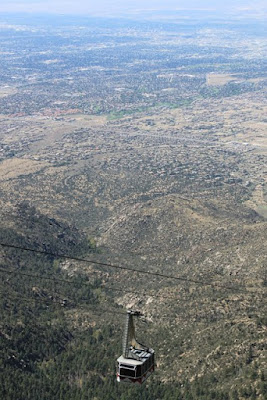We arrived in San Antonio and it was Hot! Hot! Hot! In fact, all of the places we stayed in Texas have been hot. Normally, the temperatures are in the 80's this time of year but while we were here it hit 100 each day. Needless to say, you didn't spend much time outside unless it was early in the morning.
 |
| Arriving in the city. |
 |
| Our greeter at the RV park. Only in Texas! |
 |
| The main entrance into the Alamo. |
 |
| Inside the courtyard to view the remaining buildings. |
 |
| Another view of the Alamo within the courtyard. |
 |
| There were many magnificent old trees within the fortress walls. |
The day we went to downtown San Antonio we were able to take a bus that stopped in front of the RV park we were staying in. The RV park is five miles from downtown San Antonio and is right on the San Antonio River. The city has decided to expand the Riverwalk an additional eight miles and part of that work was being completed where we were staying. Besides the downtown tourist area, the other section of the Riverwalk is used for hiking, biking, and jogging. Years ago the city had problems with flooding so an aqueduct was built to control the water but it messed up the natural ecological effects of the river. San Antonio has been correcting that problem and the Riverwalk today has many bends and turns in it designed to emulate the way it ran naturally years ago. To each side of the river there are deep banks that have plantings that are indigenous to the region. Birds and fish have returned to their natural habitat and seem to be thriving. The third phase to the Riverwalk should be finished by the end of 2012 and there will be parks and sports facilities built along with it so it will be very functional for the residents of the city.
The downtown Riverwalk is below the main streets of San Antonio and it is 10-15 degrees cooler as soon as you get down the steps. The area is beautiful and quite a place to see.
 |
| One of the downtown entrances to the Riverwalk. You walk down about 15 feet below the main street to get to the Riverwalk. These steps were inlaid with tiles. |
While in San Antonio we visited two other missions. The first was the Mission Concepcion.
 |
| The ceiling in the mission. |
 |
| The outside structure made of local limestone. |
 |
| Over the years experts have worked to restore the original artwork. |
The second mission we visited was Mission San Jose. It is no longer active but is a good example of the compound where the missionaries and Native American Indians worked and lived.
 |
| The mission from a distance. It was a good sized compound. |
 |
| This is the main area behind the church where the missionaries lived. |
 |
| Along the outer walls of the mission complex rooms were built where the Native Americans lived. |
 |
| The church of Mission San Jose. |
 |
| This is only a small piece of the original stucco that was on the buildings. The colors must have been beautiful. |
 |
| This was a mill they used to grind corn. They built an aqueduct to bring in the water to turn the wheel. |
 |
| The inside of the mill. |
 |
| The aqueduct is still in place today. |
 |
| What is left of the main entrance to the church. |
 |
| The area they used as a classroom to teach the Native Americans. |
 |
| Another section of the mission. Note the earthen roof with cactus growing on it. |
 |
| Inside the mission compound are beautiful old live oak trees. |
We left San Antonio and headed to Niceville, FL, to see our younger daughter and family. From there we headed to a Tiffin rally in Pine Mountain, GA, and now we have arrived home. We will be staying here (off and on) for a few months until January when we head out on the trail for a three month adventure along the Florida coast. One of our goals is to have a margarita and a 'cheeseburger in paradise' at Jimmy Buffett's restaurant in the Florida Keys.
Hope you all have a wonderful fall and holiday season and we will continue this blog in 2012. Peace to all.
For our trivia buffs:
How did the state of Texas get its name?
Its name comes from the Caddo tribe and the Spaniards. During the Spanish exploration of Texas in the 1540s, the Spaniards met the Hasnai Caddo tribe in present-day East Texas. The Native Americans used the word tayshas for "friends" or "allies." In Spanish, the translation came out as tejas. Eventually, Tejas became Texas.




























